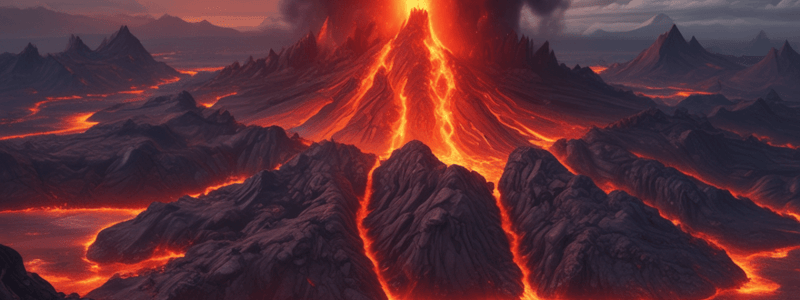Podcast
Questions and Answers
What is the primary cause of volcanic activity on Earth?
What is the primary cause of volcanic activity on Earth?
- The gravitational pull of the Moon and other celestial bodies
- The interaction of tectonic plates at divergent and subduction boundaries (correct)
- The erosion of the Earth's surface over time
- The Earth's core generating intense heat and pressure
Which of the following is not a type of volcano mentioned in the text?
Which of the following is not a type of volcano mentioned in the text?
- Composite volcano
- Caldera volcano (correct)
- Cinder-cone volcano
- Shield volcano
What is the difference between magma and lava?
What is the difference between magma and lava?
- Magma and lava are the same thing, just different names
- Magma is molten rock beneath the Earth's surface, while lava is molten rock on the surface (correct)
- Magma is a type of gas, while lava is a type of molten rock
- Magma is solid rock, while lava is molten rock
Which of the following best describes a cinder-cone volcano?
Which of the following best describes a cinder-cone volcano?
In addition to molten rock, what other materials can volcanoes eject?
In addition to molten rock, what other materials can volcanoes eject?
What is the primary difference between a lava flow and a pyroclastic flow?
What is the primary difference between a lava flow and a pyroclastic flow?
What is the meaning of the term 'pyroclastic'?
What is the meaning of the term 'pyroclastic'?
Which of the following is NOT a potential hazard associated with a pyroclastic flow?
Which of the following is NOT a potential hazard associated with a pyroclastic flow?
What is the primary difference between a pyroclastic flow and a pyroclastic surge?
What is the primary difference between a pyroclastic flow and a pyroclastic surge?
Which of the following historical volcanic eruptions is NOT mentioned in the text as an example of a pyroclastic flow?
Which of the following historical volcanic eruptions is NOT mentioned in the text as an example of a pyroclastic flow?
What is the primary reason pyroclastic surges are more likely to cause death in humans compared to pyroclastic density currents?
What is the primary reason pyroclastic surges are more likely to cause death in humans compared to pyroclastic density currents?
Which of the following statements about tephra is true?
Which of the following statements about tephra is true?
What potential hazard associated with tephra is mentioned in the text?
What potential hazard associated with tephra is mentioned in the text?
What was a consequence of the tephra produced during the 1815 eruption of Tambora?
What was a consequence of the tephra produced during the 1815 eruption of Tambora?
Why are pyroclastic density currents able to affect a smaller area than pyroclastic surges, according to the text?
Why are pyroclastic density currents able to affect a smaller area than pyroclastic surges, according to the text?
Flashcards are hidden until you start studying




